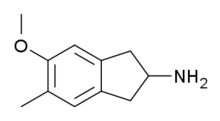MMAI
 | |
|---|---|
| Systematic (IUPAC) name | |
| 5-methoxy-6-methyl-2,3-dihydro-1H-inden-2-amine | |
| Clinical data | |
| Legal status | Uncontrolled |
| Routes | Oral |
| Identifiers | |
| CAS number | 132980-16-6 |
| ATC code | None |
| PubChem | CID 131575 |
| ChemSpider | 116274 |
| Chemical data | |
| Formula | C11H15NO |
| Mol. mass | 177.242 g/mol |
| SMILES
| |
5-Methoxy-6-methyl-2-aminoindane (MMAI), is a drug developed in the 1990s by a team led by David E. Nichols at Purdue University.[1] It acts as a non-neurotoxic and highly selective serotonin releasing agent (SSRA) and produces entactogen effects in humans.[1][2][3] It has been sold as a designer drug and research chemical online since 2010.[4]
MMAI has been shown to relieve stress-induced depression in rats more robustly than sertraline,[5] and as a result it has been suggested that SSRAs like MMAI and 4-MTA could be developed as novel antidepressants with a faster onset of therapeutic action and superior efficacy to current antidepressants such as the selective serotonin reuptake inhibitors (SSRIs). Additionally it may relieve symptoms for up to one year, or an entire lifetime of the user.[6]
See also
- 2-Aminoindane
- 5-IAI
- AMMI
- MDAI
- MDAT
References
- ↑ 1.0 1.1 Marona-Lewicka D, Nichols DE. (1994). "Behavioral effects of the highly selective serotonin releasing agent 5-methoxy-6-methyl-2-aminoindan". Eur J Pharmacol. 258 (1-2): 1–13. doi:10.1016/0014-2999(94)90051-5. PMID 7925587.
- ↑ Li Q, Murakami I, Stall S, Levy AD, Brownfield MS, Nichols DE, Van de Kar LD. (1996). "Neuroendocrine pharmacology of three serotonin releasers: 1-(1,3-benzodioxol-5-yl)-2-(methylamino)butane (MBDB), 5-methoxy-6-methyl-2-aminoindan (MMAi) and p-methylthioamphetamine (MTA)". J Pharmacol Exp Ther. 279 (3): 1261–1267. PMID 8968349.
- ↑ Rudnick G, Wall SC. (1993). "Non-neurotoxic amphetamine derivatives release serotonin through serotonin transporters". Mol Pharmacol. 43 (2): 271–276. PMID 8429828.
- ↑ "Latest Research Chemicals".
- ↑ Marona-Lewicka D, Nichols DE. (1997). "The Effect of Selective Serotonin Releasing Agents in the Chronic Mild Stress Model of Depression in Rats". Stress 2 (2): 91–100. doi:10.3109/10253899709014740. PMID 9787258.
- ↑ Neuropharmacology; Silveira, R; Nichols, DE; Reyes-Parada, M (1999). "Effects of 5-HT-releasing agents on the extracellullar hippocampal 5-HT of rats. Implications for the development of novel antidepressants with a short onset of action". Neuropharmacology 38 (7): 1055–1061. doi:10.1016/S0028-3908(99)00023-4. PMID 10428424.
| ||||||||||||||